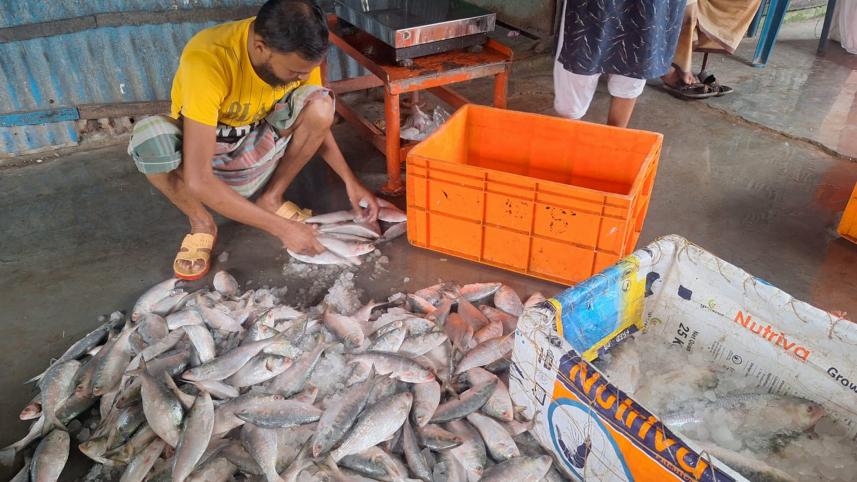Where have all the big hilsa gone?

Large-sized hilsa have almost disappeared from markets across the southern region, with traders reporting that most of the catch now weighs between 200 and 400 grammes.
These smaller hilsa are being sold for Tk 400 to Tk 600 per kilogramme. According to the Barishal Divisional Fisheries Office, 60–65 percent of the hilsa currently being caught fall within this size range.
Fishermen said that unlike in previous years, when larger fish were available at this stage of the season, this year's catch is not only smaller in quantity but also dominated by undersized fish.
The Divisional Fisheries Department noted that hilsa below 225 grammes are considered jatka, whose capture and sale are prohibited. Yet jatka and slightly larger fish are being openly sold in markets.
On Wednesday alone, around 567 tonnes of hilsa were brought to 364 markets and landing stations in Barishal division, 65 percent of which were between 200 and 400 grammes.
At Barishal Port Road's wholesale landing centre, Arif Enterprise's manager Md Shakil said most of the market supply consisted of small fish.
"A 300-gramme fish that cost Tk 1,000 per kg two days ago is now Tk 1,060. Fish weighing 700–800 grammes went up from Tk 1,960 to Tk 2,000 per kg, while one-kilo fish rose from Tk 2,210 to Tk 2,260," he said, adding that 60–70 percent of the fish were small and overall supply was about half of last year's.
Fisherman Siddik Majhi from Kuakata said that from every five maunds of fish brought to shore, three maunds consisted of 300–400 grammes of hilsa.
Traders blamed poor jatka protection drives last year for the scarcity of larger hilsa this season.
"Monsoon is supposed to bring good catches of large fish, but we haven't seen them so far," one trader said.
Shariful Islam, manager of the BFDC fish centre in Alipur, said adverse weather has kept many trawlers from going out to sea, cutting production.
"Of the 30 maunds of fish we received today [yesterday], about 25 maunds weighed between 300 and 400 grammes," he said, adding that hilsa prices have jumped by Tk 5,000 to Tk 10,000 per maund over the past few days.
Fish weighing 500–700 grammes now sell for Tk 70,000 per maund, up from Tk 60,000–65,000, while one-kilo fish that fetched Tk 70,000–80,000 are now going for Tk 90,000 per maund.
Mohammad Anisuzzaman, senior assistant director of the Barishal fisheries department, said this year's hilsa production is likely to fall compared to last year. "We have indications of a decline. The main reason is that hilsa migration routes are shifting due to navigability loss, river pollution and climate change," he said.
"As a result, larger fish are scarce, and around 65 percent of the catch consists of hilsa weighing 200–450 grammes," he added.
While catching and selling jatka is illegal, he said monitoring the vast network of rivers is difficult.
"Whenever we get reports, we conduct drives with police, and law enforcers have already been instructed to crack down harder on jatka catching and sales."

 For all latest news, follow The Daily Star's Google News channel.
For all latest news, follow The Daily Star's Google News channel.
Comments